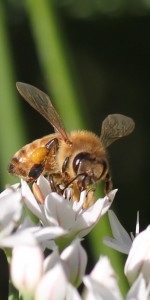Bee Books at Bates
As Samuel Coleridge and Phil Connors fans are well aware:
 ALL Nature seems at work. Slugs leave their lair—
ALL Nature seems at work. Slugs leave their lair—
The bees are stirring—birds are on the wing—
And WINTER, slumbering in the open air,
Wears on his smiling face a dream of Spring!
And I, the while, the sole unbusy thing,
Nor honey make, nor pair, nor build, nor sing.
Yet well I ken the banks where amaranths blow,
Have traced the fount whence streams of nectar flow.
Bloom, O ye amaranths! bloom for whom ye may,
For me ye bloom not! Glide, rich streams, away!
With lips unbrighten’d, wreathless brow, I stroll:
And would you learn the spells that drowse my soul?
WORK WITHOUT HOPE draws nectar in a sieve,
And HOPE without an OBJECT cannot live.
Samuel Taylor Coleridge
“Work Without Hope”
But all hope is not lost. As the bees continue their hidden preparations for the coming Spring, there is still plenty of time to busy yourself and forge a connection to their part of the natural world.
- Are you a newbie (see what I did there?) in all things related to honey bees and beekeeping, but interested to learn?
- Are you an experienced beekeeper on the lookout for another great bit of knowledge?
- Worried that the bees are all dying and we will soon be relegated to a diet of wind pollinated corn?
The Bates library has an excellent collection of books describing basic beekeeping and bee biology. A search of our catalog will turn up quite a few, but here’s a short list to get you started:
Introduction to Honeybee Biology:
For some basic and intermediate information about bees and beekeeping, you might try one (or more) of the following.
In particular, “Huber’s new observations upon bees” is a classic considered by many to be one of the seminal publications in the study of beekeeping. The publisher of this addition (Michael Bush) states: “[François Huber’s] discoveries were so revolutionary, that beekeeping can be divided in two eras very easily as pre-Huber and post-Huber”.
Initially written as collected correspondence from the blind naturalist Huber (1750-1831) to celebrated naturalist Charles Bonnet (1720-1793), this work was translated into English for American publication by famous beekeeper C.P. Dadant.
For a more modern take on many of Huber’s ideas, you might enjoy reading Michael Bush’s “The practical beekeeper”. Beekeeping after 1985 has been called by some the age of chemical pest management. Almost certainly the result of the greatly increased prevalence of parasitic mites and the viruses they carry as well as bacterial and fungal parasites, most of the American feral honeybee population has disappeared. To avoid similar colony losses, most hobbyist and commercial beekeepers began a regimen of chemical treatment to deal with these honeybee pests. A common mantra heard from many beekeepers today is “Treat or Die”. A bit of a well respected heretic in the beekeeping community, Michael Bush describes his method of treatment-free beekeeping and hive management. This book will probably spend more time checked out than in, but fear not. Nearly all of the content can be found on Michael Bush’s informative website.
Huber’s new observations upon bees : the complete volumes I & II
Author: Francis Huber
French to English translation: C.P. Dadant
Modern typesetting and image enhancement: Michael Bush
Anatomy of the honey bee
Author: R.E. Snodgrass
The biology of the honey bee
Author: Mark L. Winston
The practical beekeeper
Author: Michael Bush
Modern Studies of Beehive Social Organization:
Each of these best selling books by Cornell entomologist Thomas Seeley does a phenomenal job of describing the stimulus and response patterns related to various activities within the hive. Both are very readable and both take the standard descriptions of what happens in a hive to the level of why it might be happening.
The wisdom of the hive : the social physiology of honey bee colonies
Author: Thomas Seeley
Honeybee democracy
Author: Thomas Seeley
Authoritative Beekeeping Reference Works:
The personal libraries of many beekeepers contain one or both of the following books. Check them out to see why these encyclopedic works are considered such valuable resources.
The ABC & XYZ of bee culture : a cyclopedia of everything pertaining to the care of the honey-bee (41st Edition)
Editors: Hachiro Shimanuki and Kim Flottum
The Hive and the honey bee : a new book on beekeeping which continues the tradition of “Langstroth on the hive and the honeybee”
Editor: J.M. Graham
Historical of Beekeeping:
For a long view of beekeeping through history and in America, these books would be a good place to start. A special shout out for Eva Crane’s engaging and readable tome–not longer in print and getting harder to find, this book is clearly a work of love. Very readable and loaded with info. Also, the 1918 edition of Hutchinson’s “Advanced bee culture” (available here as a freely available Google ebook) shows how much in beekeeping hasn’t changed in the past 100 years. Again, very readable and worth a look for the images alone.
The world history of beekeeping and honey hunting
Author: Eva Crane
Bees in America: how the honey bee shaped a nation
Author: Tammy Horn
Letters from the hive: an intimate history of bees, honey, and humankind
Author(s): Stephen Buchmann with Banning Repplie
Advanced bee-culture (1918 edition)
Author: William Z. Hutchinson
Internet Resource
Honey Bee Health:
Colony Collapse Disorder (CCD) has made global headlines and many have weighed in regarding the possible cause(s) of the significant increase in honeybee colony failure as well as the effects the loss of these pollinators would have on the global food supply. Here are a few sources that deal with this potential crisis.
Fruitless fall : the collapse of the honey bee and the coming agricultural crisis
Author: Rowan Jacobsen
A spring without bees: how colony collapse disorder has endangered our food supply
Author: Michael Schacker